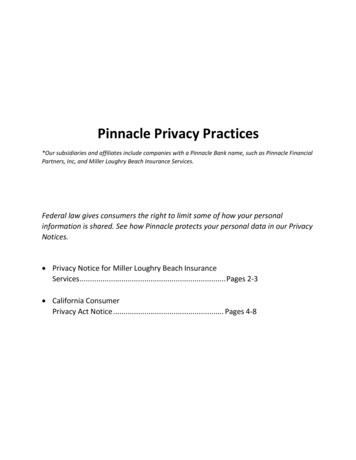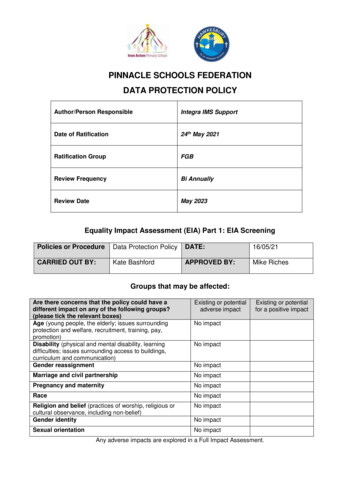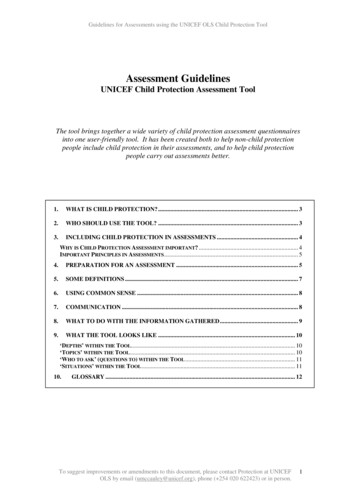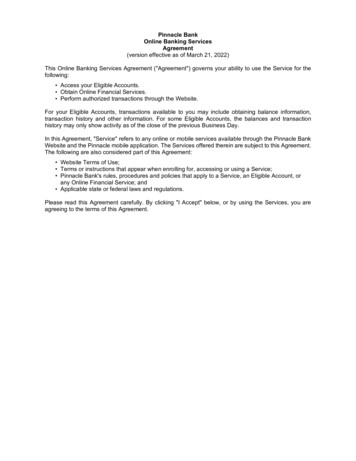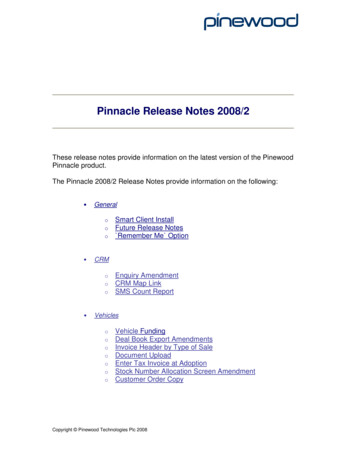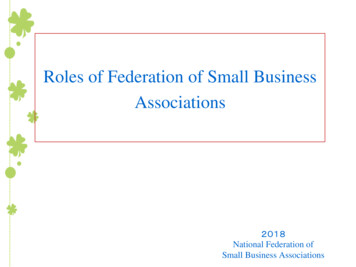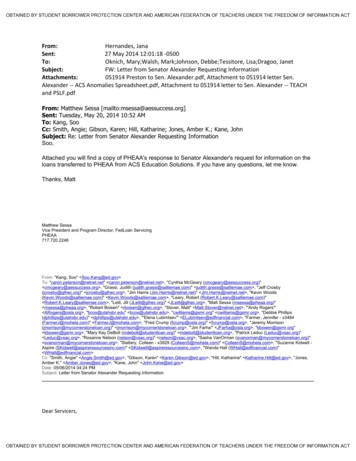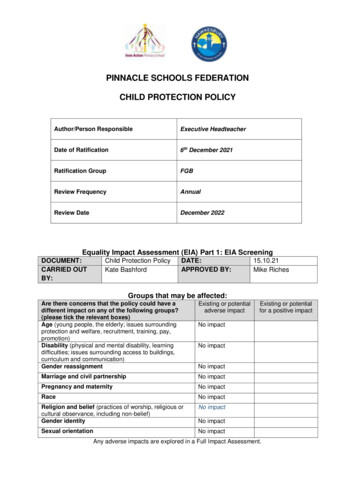
Transcription
PINNACLE SCHOOLS FEDERATIONCHILD PROTECTION POLICYAuthor/Person ResponsibleExecutive HeadteacherDate of Ratification6th December 2021Ratification GroupFGBReview FrequencyAnnualReview DateDecember 2022Equality Impact Assessment (EIA) Part 1: EIA ScreeningDOCUMENT:CARRIED OUTBY:Child Protection PolicyKate BashfordDATE:APPROVED BY:15.10.21Mike RichesGroups that may be affected:Are there concerns that the policy could have adifferent impact on any of the following groups?(please tick the relevant boxes)Age (young people, the elderly; issues surroundingprotection and welfare, recruitment, training, pay,promotion)Disability (physical and mental disability, learningdifficulties; issues surrounding access to buildings,curriculum and communication)Gender reassignmentExisting or potentialadverse impactExisting or potentialfor a positive impactNo impactNo impactNo impactMarriage and civil partnershipNo impactPregnancy and maternityNo impactRaceNo impactReligion and belief (practices of worship, religious orcultural observance, including non-belief)Gender identityNo impactSexual orientationNo impactNo impactAny adverse impacts are explored in a Full Impact Assessment.
1) Purpose of the PolicyAt The Pinnacle Schools Federation we are committed to creating and embedding a culture ofvigilance which: Ensures we maintain an attitude of “It could happen here” Ensures that our learners are safe and protected Ensures that our learners know who to talk to if they have concerns and are assuredthat their voices are heard Ensures that our learners are supported, protected and informed Ensures that our learners are safe from discrimination and bullying Ensures that our learners recognise when they are at risk and know how to get helpwhen they need it Ensures that our learners understand about how to keep themselves safe as part of abroad and balanced PSHE and online safety curriculum Focuses on preventative work in relation to adverse childhood experiences (ACEs) andtakes an ACE aware approachThis policy applies to all staff, students, governors, cover staff and volunteers.Information SharingThe school’s information sharing policy is based on the guidance document ‘Informationsharing: advice for practitioners providing safeguarding services’ (DfE, 2018).Keeping Children Safe in Education (2021), paragraph 60: ‘the Data Protection Act 2018 (DPA)and UK General Data Protection Regulation (UK GDPR). DPA and UK GDPR do not prevent thesharing of information for the purposes of keeping children safe and promoting their welfare.KCSIE 2021, paragraph 109: ‘This includes allowing practitioners to share information withoutconsent where there is good reason to do so, and that the sharing of information will enhancethe safeguarding of a child in a timely manner, but it is not possible to gain consent, it cannotbe reasonably expected that a practitioner gains consent, or if to gain consent would place achild at risk’.1.1We take seriously our statutory and moral responsibilities to protect and safeguardthe welfare of the children and young people in their care - “The welfare of the childis paramount.” (Children Act 1989)1.2We will follow procedures set out by the South Gloucestershire Children’s Partnership,which comprises of the council, the clinical commissioning group and the Police andtake account of guidance issued by the DFE and the Local Authority (LA). The schoolwill work under these arrangements as a named children/1.3We recognise that staff, because of their contact with and knowledge of children oryoung people in their care, are well placed to promote the well-being of children,protect them from harm, and respond to child protection or safeguarding concerns.
1.4As part of the ethos of the school, the staff and governors are committed to: ensuring the school practises safe recruitment in checking the suitability of staffand volunteers to work with students ensuring that all staff and volunteers understand, and adhere to, the school’s codeof conduct student health and safety providing first aid as and when required having clear processes regarding intimate care meeting the needs of our students with medical conditions having systems which support early identification and early help through the earlyhelp assessment process which is provided by the South Gloucestershire Compasspartnership team developing Inclusive practice which promotes the voice of the child and seeks toreduce the barriers that students from vulnerable backgrounds may have andwhich may in turn affect their mental health and wellbeing, as well as their abilityto share information about maltreatment and abuse establishing and maintaining a safe school environment, where all students feelsecure, can learn and develop, are encouraged to talk and are listened to; including opportunities in the strands of the PSHE, Computing curriculum andwhole school approach to care, guidance and support, for students to develop theskills they need to recognise, and stay safe from abuse using the updated guidance on Teaching Online Safety in school June 2019 toreview the learning opportunities for students in school (document link) having regard to the DfE statutory guidance 2020 relationships education which iscompulsory in all Primary Schools and that relationships and sex education iscompulsory in all secondary schools (guidance link) ensuring all teaching and support staff are aware of signs and symptoms of abuse,know the correct procedure for referring concerns or allegations against staff andreceive appropriate training to enable them to carry out these requirements ensuring all volunteers understand their responsibilities in being alert to the signsof abuse and responsibility for referring any concerns to the designated personresponsible for child protection exercising their duty to work in partnership with other agencies and to shareinformation with them, including attendance at child protection conferences, coregroups and preparation of reports for conferences encouraging and supporting parents/carers, working in partnership with them supporting students in accordance with their agreed child protection plan a child centred approach, making it clear what our staff should do to keepchildren safe. ensuring students know they can talk to staff confidentially by reminding them inassemblies, updating the safeguarding noticeboard and signposting them asrequired.Safeguarding Young PeopleSafeguarding and promoting the welfare of children is defined for the purposes of this policyas: protecting children from maltreatment
preventing impairment of children's mental health and physical health or development ensuring that children grow up in circumstances consistent with the provision of safe andeffective care taking action to enable all children to have the best outcomes.Children includes everyone under the age of 18.2) Relationship to other policiesAs well as ensuring that we address child protection concerns, we will also ensure thatchildren who attend our school are kept safe from harm whilst they are in our charge. To thisend, this policy should be read in conjunction with other relevant polices:- Anti-bullying- Positive Behaviour- Staff Code of Conduct- Complaints- Educational Visits- Equalities- Exclusions- Grievances- Health and Safety- Medical Needs (including Intimate Care)- Online Safety- PSHE- Relationships and sex education- Safer Recruitment- Whistle-blowing3) Roles & ResponsibilitiesThe Designated Safeguarding Lead (DSL)The Designated Safeguarding Leaders with responsibility for safeguarding and ChildProtection (including online safety) are Sarah Bagnall (Iron Acton) and Ed Riddington(Hawkesbury): these people are members of the Federation’s Senior Leadership Team. TheDeputy Safeguarding leads are: Mike Riches and Christine Wilson (both schools).The Designated Safeguarding Leaders work closely with the Computing Leaders. They are:Jess Abley (Iron Acton) and Alec Bryant (Hawkesbury).During term time, the DSL will be available during school hours for staff to discuss anysafeguarding concerns.The DSL can be contacted out of hours using the emailsarah.bagnall@ironactonprimaryschool.co.uk and ed.riddington@hawkesbury.org.uk.When the DSL is absent, the deputies will act as cover and can be contacted usingChristine.wilson@pinnacleschools.org.uk and mike.riches@pinnacleschools.org.uk.If the DSL and Deputies are not available, the contact at the other school in the Federationwill act as cover (for example, during out-of-hours/out-of-term activities).All trips leaving the school will have the DSL mobile telephone number on their trip packinformation.
3.1All staff will be made aware of who the Designated Safeguarding Lead is and whattheir role is3.2Annex C, Keeping Children Safe in Education 2021, sets out clearly the requirementsfor the DSL in schools. (document link)The role of the Designated Safeguarding LeadWhilst the activities of the designated safeguarding lead can be delegated to appropriatelytrained deputies, the ultimate lead responsibility for safeguarding and child protection, as setout below, remains with the designated safeguarding lead. This responsibility should not bedelegated.Managing referralsThe designated safeguarding lead is expected to: refer cases of suspected abuse and neglect to the local authority children’s social care asrequired and support staff who make referrals to local authority children’s social care refer cases to the Channel programme where there is a radicalisation concern as requiredand support staff who make referrals to the Channel programme refer cases where a person is dismissed or left due to risk/harm to a child to the Disclosureand Barring Service as required and in liaison with the Head of Personnel refer cases where a crime may have been committed to the Police as required. NSPCC- Whento call the police should help understand when to consider calling the police and what toexpect when working with the police. When to call the police - NSPCCWork with othersThe designated safeguarding lead is expected to: act as a point of contact with the three safeguarding partners (Local authority, the clinicalcommissioning group (CCG) and the chief officer of police for an area any part of which fallswithin the council area). liaise with the Executive Headteacher to inform them of issues - especially ongoing enquiriesunder section 47 of the Children Act 1989 and police investigations as required, liaise with the “case manager” (as per Part four) and the designated officer(s)at the local authority for child protection concerns in cases which concern a staff member liaise with staff (especially pastoral support staff, school nurses, IT Technicians, and SENCOs)on matters of safety and safeguarding (including online and digital safety) and when decidingwhether to make a referral by liaising with relevant agencies; and act as a source of support, advice and expertise for all staff.TrainingThe Designated Safeguarding Lead and any deputies will be trained to an advanced level byattending Advanced Inter-agency Child Protection training and this will be maintained byattending CP Update training every 2 years thereafter. The DSL will undertake Preventawareness training. This training will provide them with a good understanding of their ownrole and the process, procedures and responsibilities of other agencies, particularlychildren’s social care, so they can:
understand the assessment process for providing early help and statutoryintervention, including local criteria for action and local authority children’s social carereferral arrangements.have a working knowledge of how local authorities conduct a child protection caseconference and a child protection review conference and be able to attend andcontribute to these effectively when required to do so;ensure each member of staff has access to, and understands, the school’s safeguardingand child protection policy and reporting procedures, especially new and part timestaffensure all new staff attend safeguarding induction training and that relevant staff haveread and understand Part 1 and Annex A (if working directly with children) of KCSIE2021ensure that all staff have read Part 1 and Annex A (if working directly with children) ofKCSIE and provide a yearly update training session during INSET to all staff as well ason-going CPD during the year for staff to support the culture of safeguardingare alert to the specific needs of children in need, those with special educational needsand young carersunderstand relevant data protection legislation and regulations, especially the DataProtection Act 2018 and the General Data Protection Regulationunderstand the importance of information sharing, within the school, and with thethree safeguarding partners, other agencies, organisations and practitionersare able to keep detailed, accurate, secure written records of concerns and referralsusing paper recordsunderstand and support the school with regards to the requirements of the Preventduty and are able to provide advice and support to staff on protecting children fromthe risk of radicalisationare able to understand the unique risks associated with online safety and be confidentthat they have the relevant knowledge and up to date capability required to keepchildren safe whilst they are online at school or at homecan recognise the additional risks that children with SEN and disabilities (SEND) faceonline, for example, from online bullying, grooming and radicalisation and areconfident they have the capability to support SEND children to stay safe onlineobtain access to resources and attend any relevant or refresher training coursesencourage a culture of listening to children and taking account of their wishes andfeelings, among all staff, in any measures the school or college may put in place toprotect them. In addition to the formal training set out above, their knowledge andskills should be refreshed (this might be via bulletins, meeting other designatedsafeguarding leads at DSL Forums and participating in training and school reviews, orsimply taking time to read and digest safeguarding developments) at regular intervals,as required, and at least annually, to allow them to understand and keep up with anydevelopments relevant to their roleKeep a training plan for the school which shows all training throughout the yearRaise AwarenessThe designated safeguarding lead will: ensure the school’s safeguarding and child protection policy is known, understood andused appropriately
ensure the school’s safeguarding and child protection policy is reviewed annually (asa minimum) and the procedures and implementation are updated and reviewedregularly, and work with governing bodies or proprietors regarding thisensure the safeguarding and child protection policy is available publicly and parentsare aware of the fact that referrals about suspected abuse or neglect will be made andthe role of the school in thislink with the safeguarding partner arrangements to make sure staff are aware of anytraining opportunities and the latest local policies on local safeguarding arrangements.help promote educational outcomes by sharing the information about the welfare,safeguarding and child protection issues that children, including children with a socialworker, are experiencing, or have experienced, with all school staff so that staff knowwho these children are, understand their academic progress and attainment andmaintain a culture of high aspirations for this cohortsupport teaching staff to identify the challenges that children in this group might faceand the additional academic support and adjustments that they could make to bestsupport these children.Child protection fileWhere children leave the school (including for in-year transfers) the designated safeguardinglead will ensure their child protection file is transferred to the new school or college as soonas possible ‘to allow the new school or college to continue supporting children who have hada social worker and been victims of abuse and have that support in place for when the childarrives’ This will be transferred separately from the main pupil file, ensuring secure transit,and confirmation of receipt will be obtained. In addition to the child protection file, thedesignated safeguarding lead will also consider if it would be appropriate to share anyinformation with the new school or college in advance of a child leaving. For example,information that would allow the new school or college to continue supporting victims ofabuse and have that support in place for when the child arrives. (As per KCSIE 2021 paragraphs112 & 113)ReportingThe DSL will meet regularly with the safeguarding link governor for the Federation. This is DebMarriage Deb.marriage@pinnacleschools.org.uk. The safeguarding link governor will reportback to the FGB at each meeting.The annual Safeguarding audit will be conducted and an action plan created. This will bereviewed regularly and shared with relevant staff and governors.School safeguarding profileOur safeguarding analysis has shown that our main concerns are in the area of online safetyand mental health. In addition, the security of the site at Iron Acton is an ongoing area forimprovement.Our school will be alert to the potential needs of the following vulnerable children inrelation to safeguarding and child protection and in their need for early help:Children and young people with special educational needs and disabilities can faceadditional safeguarding challenges because: there may be assumptions that indicators of possible abuse such as behaviour,mood and injury relate to the child’s disability without further exploration;
children with SEN and disabilities can be disproportionally impacted by things likebullying without outwardly showing any signs; and difficulties may arise in overcoming communication barriers; children with special educational needs, without an EHCP could be more vulnerable; they are often isolated, may have difficulty in communicating effectively and lackconfidence to talk to adultsOur internal support processes will ensure that students with SEN and disabilities haveadequate pastoral care. This is supported by the work of the SENCO. Children causingconcern are discussed as part of weekly SLT meetings and through staff meetings andfortnightly inclusion meetings.Other vulnerable groups that we monitor closely that may need early help processes in placestudents who: have English as an additional language are young carers have previously suffered peer on peer abuse are showing signs of engaging in anti-social or criminal behaviour have previously been looked after and are now adopted from care as they remainpotentially vulnerable are misusing drugs or alcohol are at risk of being radicalised or exploited are privately fostered children are at risk of modern slavery, trafficking and or exploitation, such as county lines are in a family circumstance presenting challenges for the child, such as substanceabuse, adult mental health problems and domestic violence have returned home to their family from care are showing early signs of abuse and/or neglect where contextual safeguarding issues are knownPreventing HarmWe recognise that developing the necessary qualities (e.g. emotional resilience, selfconfidence) within both the children themselves and the school as a whole can help toprevent harm.The school will therefore: establish and maintain an ethos where children and young people feel secure, areencouraged to talk and are listened to ensure children and young people know that there are adults in the school who theycan approach if they are worried or in difficulty ensure pupils are taught about safeguarding, including online safety, through variousteaching and learning opportunities as part of our broad and balanced curriculum.Included are the curriculum activities and opportunities that equip children andyoung people with the skills they need to stay safe from abuse and ensure that they
know who to turn to for help, mainly through our PSHE, online safety programme,relationships and sex education programme; this includes visits and workshopsprovided by the NSPCC and subject specific matter covered in to online safety focusdays and anti-bullying focus days; andinclude in the curriculum materials which will help children and young peopledevelop realistic attitudes to the responsibilities of adult life, particularly with regardto the care of children and young people.Early HelpKeeping Children Safe in Education 2021 states that “All staff should be prepared to identifychildren who may benefit from early help. Early help means providing support as soon as aproblem emerges at any point in a child’s life, from the foundation years through to theteenage years”. Staff should discuss early help requirements with the DSL (or a deputy). Wefollow the South Gloucestershire early help process which includes the use of the Early HelpAssessment and Plan (EHAP). It may be appropriate for a member of school staff to initiatean EHAP and take on the role of Lead Professional or become a member of a Team aroundthe Child/Family (TAC/F) as part of the EHAP process. If this is the case, then the staffmember should be supported by the DSL, for example, by being given time to write theEHAP and attend TAC/F meetings. All staff should have an understanding of the EHAPprocess and how they can contribute to it as and when appropriate.Local Authority Designated Officer (LADO)Tina Wilson. Contact details are:Tel. 01454 868508Email. lado@southglos.gov.uk4) Types of abuse and specific safeguarding issuesChild Criminal ExploitationChild Sexual ExploitationChildren Missing from EducationChildren with a social workerChildren and the Court SystemChildren with family members in prisonCounty LinesDomestic AbuseDrugsFabricated illnessFaith AbuseFemale Genital Mutilation (FGM)Forced MarriageGangs and ViolenceHomelessnessHonour based AbuseMental HealthPreventing radicalisation and being drawn into extremismPeer on Peer abuse including sexual violence and sexual harassmentPrivate Fostering
Serious youth violenceSextingTeenage abusive relationshipsTrafficking and modern slaveryUpskirtingFurther information about these specific issues can be found in Keeping Children Safe inEducation 2021: Annexe 914/KCSIE 2021 September guidance.pdfIndicators of abuse and neglectAbuseA form of maltreatment of a child. Somebody may abuse or neglect a child by inflicting harmor by failing to act to prevent harm. Children may be abused in a family or in an institutionalor community setting by those known to them or, more rarely, by others. Abuse can takeplace wholly online, or technology may be used to facilitate offline abuse. Children may beabused by an adult or adults or by another child or children.PHYSICAL ABUSEA form of abuse which may involve hitting, shaking, throwing, poisoning, burning orscalding, drowning, suffocating or otherwise causing physical harm to a child. Physical harmmay also be caused when a parent or carer fabricates the symptoms of, or deliberatelyinduces, illness in a child.EMOTIONAL ABUSEThe persistent emotional maltreatment of a child such as to cause severe and adverseeffects on the child’s emotional development. It may involve conveying to a child that theyare worthless or unloved, inadequate, or valued only insofar as they meet the needs ofanother person. It may include not giving the child opportunities to express their views,deliberately silencing them or ‘making fun’ of what they say or how they communicate. Itmay feature age or developmentally inappropriate expectations being imposed on children.These may include interactions that are beyond a child’s developmental capability as well asoverprotection and limitation of exploration and learning, or preventing the child fromparticipating in normal social interaction. It may involve seeing or hearing the ill-treatmentof another. It may involve serious bullying (including cyberbullying), causing childrenfrequently to feel frightened or in danger, or the exploitation or corruption of children.Some level of emotional abuse is involved in all types of maltreatment of a child, although itmay occur alone.SEXUAL ABUSEInvolves forcing or enticing a child or young person to take part in sexual activities, notnecessarily involving a high level of violence, whether or not the child is aware of what ishappening. The activities may involve physical contact, including assault by penetration (forexample rape or oral sex) or non-penetrative acts such as masturbation, kissing, rubbing andtouching outside of clothing. They may also include non-contact activities, such as involvingchildren in looking at, or in the production of, sexual images, watching sexual activities,encouraging children to behave in sexually inappropriate ways, or grooming a child inpreparation for abuse. Sexual abuse can take place online, and technology can be used tofacilitate offline abuse. Sexual abuse is not solely perpetrated by adult males. Women can
also commit acts of sexual abuse, as can other children. The sexual abuse of children byother children is a specific safeguarding issue in education (see paragraph 29 in KeepingChildren Safe in Education 2021).NEGLECTThe persistent failure to meet a child’s basic physical and/or psychological needs, likely toresult in the serious impairment of the child’s health or development. Neglect may occurduring pregnancy, for example, as a result of maternal substance abuse. Once a child is born,neglect may involve a parent or carer failing to: provide adequate food, clothing and shelter(including exclusion from home or abandonment); protect a child from physical andemotional harm or danger; ensure adequate supervision (including the use of inadequatecare-givers); or ensure access to appropriate medical care or treatment. It may also includeneglect of, or unresponsiveness to, a child’s basic emotional needs.5) The Management of SafeguardingGoverning Body5.0The Governing Body (GB) will have a Designated Governor with responsibility forSafeguarding; this is Deb Marriage.The Designated Governor will ensure that they utilise the experiences and expertiseof staff when shaping safeguarding polices. Opportunities for staff to contribute tosafeguarding arrangements and child protection will be provided. They will also beresponsible for jointly undertaking the annual 175 safeguarding audit with theExecutive Headteacher and Designated Safeguarding Lead. An action plan followingthe audit will be produced and the GB will ensure that any actions are met in a timelymanner.5.1The GB will receive the Annual Safeguarding Report and will review safeguardingpractices in the school no less than annually to ensure that: The school carries out its statutory duties related to child protection andsafeguarding, including the South Gloucestershire Children’s Partnershiprequirements Sufficient resources are made available to enable necessary tasks to be carried outproperly under inter-agency procedures Governors attend Child Protection / Safeguarding training Only persons suitable to work with children shall be employed in the school orwork in a voluntary capacity as detailed in Keeping Children Safe in Education 2021 Where safeguarding concerns about a member of staff are substantiated,appropriate action is taken.The GB will delegate responsibility for day-to-day procedures that ensure the smoothoperational practice for safeguarding arrangements to the Executive Headteacher andDesignated Safeguarding Leads; this may be reported to Governors retrospectively.Children missing from educationThe GB will ensure that appropriate safeguarding responses to children who gomissing from education are in place, particularly on repeat occasions, to help identifythe risk of abuse and neglect, including sexual abuse or exploitation, and to helpprevent the risk of them going missing in future.
Where reasonably possible, the school will hold more than one emergency contactnumber for each pupil. This goes beyond the legal minimum and is good practice togive the school additional options to make contact with a responsible adult when achild missing education is also identified as a welfare and/or safeguarding concern.5.2The GB will ensure that weaknesses identified within the Annual report; through ongoing monitoring of safeguarding and child protection procedures and other sources,are addressed explicitly within the School Improvement Plans. The governing bodywill regularly monitor the implementation and impact of the identified actions.5.3The GB will ensure that appropriate filters and monitoring systems are in place for theschool and will identify the steps required to ensure that the monitoring of internetuse, particularly for vulnerable students such as those with special educational needsand disabilities, is robust. Advice and recommendation from the Safer Internet Centrewill be used to fulfil this role.5.4The GB controls the use of the school premises both within and outside school hoursand has a duty to safeguard children and young people using the premises. Whereservices or activities are provided separately by another body, the GB will seekassurances that the body concerned has appropriate policies and procedures in placein regard to safeguarding children and child protection.HR/Personnel Lead5.5Part 3 of KCSIE 2021 sets out clearly the requirements and processes in relation toSafer Recruitment and these are fully detailed in the Safer Recruitment policy.In addition to the requirements within the Safer Recruitment policy, the HR/PersonnelLead will ensure that: All volunteers to the school have read the Part 1 Keeping Children Safe in Edu
PINNACLE SCHOOLS FEDERATION CHILD PROTECTION POLICY Author/Person Responsible Executive Headteacher Date of Ratification 6th December 2021 Ratification Group FGB Review Frequency Annual Review Date December 2022 Equality Impact Assessment (EIA) Part 1: EIA Screening DOCUMENT: Child Protection Policy DATE: 15.10.21 CARRIED OUT BY: Kate Bashford APPROVED BY: Mike Riches Groups that may be .
